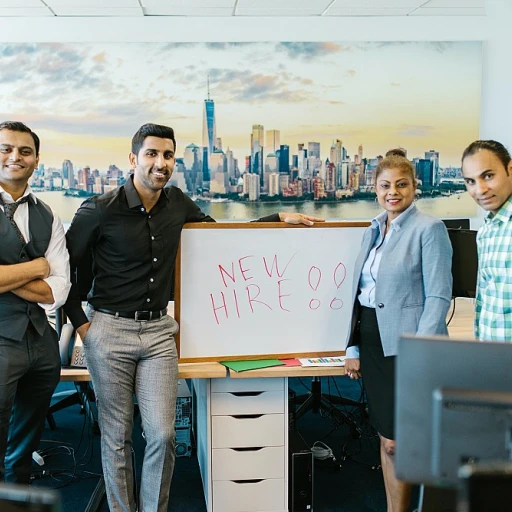
Understanding the Role of Employment Reference Letters in Succession Planning
The Importance of Reference Letters in Succession Planning
Understanding the integral role of employment reference letters in succession planning can provide a solid foundation for both employees and employers. In the realm of professional growth, these letters serve as a potent tool for communication, especially when evaluating the potential of a candidate for higher responsibilities within a company.
Employment reference letters are not only a testament to the candidate's past achievements, skills, and work ethic, but they also provide insight into the individual’s character and potential for future roles. In the context of succession planning, having well-documented reference letters can substantiate the employer’s decision-making process, thus ensuring that the right successors are chosen for critical positions.
For companies, reference letters serve as evidence of an employee’s capabilities and track record. By providing specific examples of the employee's skills and experiences, these letters highlight the candidate’s strengths and areas where they have demonstrated significant leadership qualities. This will help to align their potential with the organization’s future needs.
Moreover, the content and quality of these reference letters can greatly impact the candidate’s career trajectory. Success in future job applications often hinges on the narrative conveyed through these recommendation letters. By writing personalized and detailed letters, employers offer an invaluable endorsement of their personnel’s abilities, which is crucial in nurturing leadership talent.
For more insights on how recruiters play a pivotal role in this process, you might want to explore the role of recruiters in succession planning.
Key Elements of a Strong Employment Reference Letter
Essential Components of a Holistic Recommendation
Crafting an employment reference letter that serves the purpose of succession planning effectively involves understanding and incorporating several key elements. These components not only enhance the credibility of the candidate but also align with the company's long-term strategic goals. Let's explore the foundational aspects that every reference letter should include to support a successful succession planning process.
Comprehensive Job Title and Responsibilities
Start by clearly stating the employee's job title and a concise overview of their responsibilities within the company. This provides the basis for understanding the context of their skills and accomplishments. It helps the employer to evaluate how the employee has grown within their current position and how they might fit into future roles, thereby supporting the company's succession planning process.
Illustrating Skills and Experience
An effective reference letter will provide specific examples of the employee's skills and experiences that are pertinent to the role they are being considered for. This can include instances where the employee demonstrated leadership, problem-solving abilities, or innovative thinking. By articulating these attributes, the letter can clearly demonstrate how the employee has contributed to the company and how they will continue to do so in a new capacity.
Character and Work Ethic Endorsements
Including a character reference within the letter is crucial. Highlight aspects of the candidate's work ethic, professionalism, and interpersonal skills. A strong emphasis on these traits can assure the employer that the candidate will perform beyond expectations in a higher capacity, thus enhancing the succession planning strategy.
Contact Information for Further Details
Conclude the reference letter by providing contact information, such as a phone number or email address, allowing the employer to reach out for further clarification if needed. This enhances the credibility of the recommendation and shows a willingness to engage in further dialogue, which can provide valuable insights into the candidate’s potential for succession.
For more nuanced strategies in crafting these essential letters, consider exploring effective corporate strategies for succession planning.
Tailoring the Reference Letter to Succession Needs
Adapting Your Reference Letter for Succession Goals
When it comes to writing a reference letter tailored specifically for succession planning, it's crucial to hone in on elements that align with the long-term goals of the organization. The reference should not only spotlight the candidate's general competencies and skills but also how these skills align with prospective leadership roles.
First, ensure the letter outlines the employee's work ethic and reliability. This will reassure potential employers that the candidate exhibits traits essential for leadership. Highlight specific instances where the employee took on increased responsibilities or led projects successfully.
- Emphasize Leadership Skills and Experience: Reference specific examples where the candidate demonstrated leadership potential. This could involve managing a team or stepping in for a higher-level role.
- Relate to the Company's Mission: Link the employee's attributes to the broader objectives of the company. This puts their accomplishments in context of how they could contribute to the company's future success.
- Use of Specific Examples: When you write about the candidate's skills, include specific scenarios to illustrate their ability to meet the expected challenges of a future position.
Remember, succession planning is about preparing for future transitions and ensuring that the company has a pipeline of skilled and competent leaders. Crafting a reference letter that aligns with these goals will bolster the employee's potential for advanced roles. It not only assists the individual in their career progression but also supports the long-term sustainability of the organization.
Common Mistakes to Avoid in Employment Reference Letters
Avoiding Pitfalls in Reference Letter Writing
Crafting an effective employment reference letter is fundamental in supporting an employee's growth and aligning with succession planning goals. However, certain pitfalls can impede its effectiveness. Below are some crucial missteps to avoid when writing these letters:- Lack of Specificity: A vague reference letter devoid of specific examples significantly undermines credibility. Ensure to include precise details about the candidate's accomplishments, job title, and responsibilities that contribute to a robust recommendation.
- Over-focus on General Skills: While it's useful to highlight general attributes such as a hardworking nature or strong work ethic, it's imperative to hone in on the specific skills and experiences that align with the succession needs.
- Omissions of Professional Achievements: Neglecting to mention significant achievements can limit the letter's impact. Provide details on the candidate's professional recognitions or landmark projects that underscore their capability to advance within the company.
- Ignoring the Company's Culture: Understanding and reflecting the company’s values within the letter can greatly enhance its relevance. Mention how the employee embodies these values in their work.
- Failure to include Contact Information: Always include a reliable phone number or email address. This offers the new employer an opportunity to follow up for further reference, thereby enhancing the letter's integrity.
- Use of a Template Without Personalization: While a letter template can guide the writing process, ensure it is tailored to address the specific context of the employee’s role and the expectations of the future position.
The Impact of Reference Letters on Career Development
Boosting Career Growth through Effective References
The influence of a well-crafted employment reference letter on an individual's career development cannot be overstated. A reference letter that is aligned with the company's succession planning framework helps highlight specific skills and experiences that a candidate possesses, building a strong case for their advancement within an organization. When writing a reference letter, it is crucial to provide concrete examples of an employee's work ethic and job performance. This endorsement can serve as an internal recommendation, boosting an employee's visibility for leadership roles and special projects. By recognizing and documenting an employee's accomplishments, a reference letter can effectively advance their career trajectory. A well-documented letter should include the employee's job title, key achievements, and any specific skills or experiences that make them a suitable candidate for future roles. This information not only confirms the professional standards upheld by the employee but also reinforces the employer's commitment to developing internal talent. A professional recommendation letter also serves as a character reference, underscoring the employee's integrity and dedication. Including contact details such as a phone number for further queries lends an additional layer of credibility to the letter. This will provide potential employers or internal review panels with the reassurance needed to make informed decisions about the candidate's future within the company. Moreover, strong reference letters can pave the way for job promotions and additional responsibilities, allowing the employee to further hone their skills and gain broader experience. By positioning an employee in line for the organization's future needs, a reference letter can be instrumental in shaping both the individual's career path and the employer's succession plan.Best Practices for Writing Employment Reference Letters
Optimizing Employment Reference Letters with Proven Strategies
When crafting employment reference letters, adhering to best practices can significantly enhance their effectiveness in succession planning. Writing a reference letter requires not only an understanding of the candidate's professional capabilities but also a strategic approach to emphasizing their skills experience.- Highlight Specific Achievements: When discussing the employee's contributions, provide specific examples of their accomplishments and contributions to the company. This gives employers a clearer picture of what the candidate can bring to a new role.
- Understand the Employer's Needs: Before writing, consider what the hiring company or specific job role requires. Aligning the reference with these needs means tailoring the letter to highlight the employee's relevant skills and experiences.
- Use a Professional Tone: Keeping a professional tone throughout the letter recommendation will ensure that it is taken seriously. Respect and formality should be evident, regardless of the familiarity with the candidate.
- Include Contact Information: Provide your phone number and email address so that future employers or anyone interested in further details about the candidate can reach out for any clarifications. This demonstrates openness and willingness to support the employee further.
- Focus on Growth Potential: Employee reference letters can make a lasting impression by not only detailing past successes but also emphasizing the potential for future growth. Speaking to the candidate’s capabilities and readiness for new challenges within a professional context is key.












